FRIDAY
NOVEMBER 15 - 2013
BROOK
MEADOW
Water
Rail
I had a walk through
the meadow this morning, mainly to look for Water Rail
following the discovery of a dead one in Lumley Road
on Nov 11. I looked at all the places along both the
River Ems and the Lumley Stream where Water Rail has
been seen in the past, but there was no sign of one.
However, when I got home a note was waiting for me
from Pam Phillips to say she had seen one from the
south bridge on the east bank of the river at 11am
this morning. This was our first Water Rail sighting
of the winter, about a month earlier than last year's
first on 18-Dec-12. I had another look along the river
this afternoon, again without luck, though I did meet
Pam who told me the full story. I was surprised that
she did not know about the dead Water Rail.
Water Rail could be
confused with Moorhen, but has longer bill, slate grey
face and chest and bold black and white barring on
flanks.
Flowering
plants
The most common
flowering plant on the meadow at present is White
Dead-nettle which can be seen in many areas. Several
tall Hogweed plants still have full flowering umbels.
The only grasses I could see with spikelets were
Annual Meadow-grass and False Oat-grass. I found
Hedge Woundwort in flower along the main river
path. What a fine flower that is.

OTHER
NEWS
Nore
Barn to Warblington
Peter Milinets-Raby
was out this morning for a walk from Nore Barn along
the shoreline to Pook Lane, then back via the
Warblington Church and the main South Way footpath. He
started at 7:30am and returned to the car at 9:47am
and saw a very fine nice sunrise.
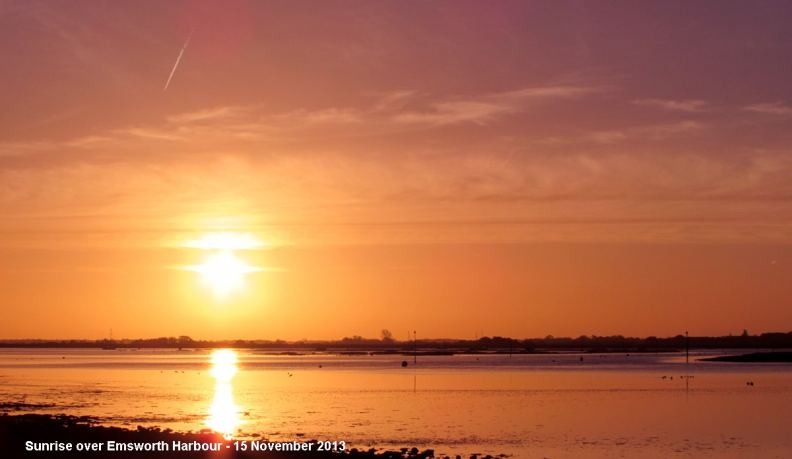
The birding highlights
were as follows: (High tide due at 9:30am)
Nore Barn:
Black-tailed Godwits 123 (up to their tummies in water
- just two coloured ringed birds noted - W-R/WN and
L-R/LL), Greenshank and Spotted Redshank in stream, 7
adult & 1 juv Mute Swan, 2 Knot, 160+ Dunlin, 183
Brent Geese, 157 Wigeon, 86 Teal, 2 Grey Plover.
A huge flock of 850+
Wood Pigeon heading north west at 7:50am (Then later
near Warblington Church three other flocks observed:
170+, 210+ and 80+ - all heading north
west)
On the point just
around the corner from Nore Barn: 3 Reed Bunting, In
the stubble field 7 Skylarks and a flock of 60+
Linnets (plus Sparrowhawk chasing them),
Conigar Point; (no mud
left) 77 Wigeon, 36 Brent Geese, 15 Lapwing, 10
Black-tailed Godwit,
Off Pook Lane:
Chiffchaff , 47 Brent Geese, 14 Wigeon, 48 Curlew in
the field here. 2 Fieldfare flying over.
Missing
swans?
Chris Oakley thought
he may have found the missing swans from Emsworth
Millpond. He counted 62 at Cut Mill creek, Chidham
this morning.
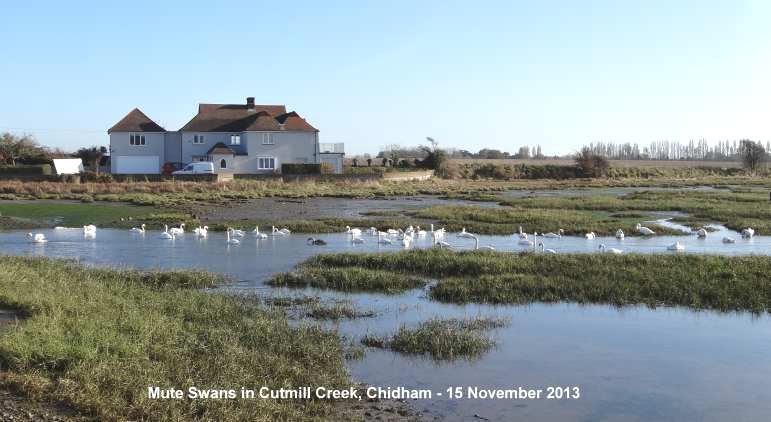
This is possible,
though I know from past counts that there are usually
substantial swan flocks in the Bosham and Fishbourne
channels. Chris and his wife, Ann, did their good turn
for the day in shepherding a swan family with a cygnet
from the A259 road, where they were holding up all the
traffic, back to the creek.
Chris also sent me
this dramatic full frontal of a Coot on Peter
Pond - the view another bird might see. 'Don't mess
with me' it seems to be saying. What a fearsome
fellow! No wonder other birds keep out of its way.
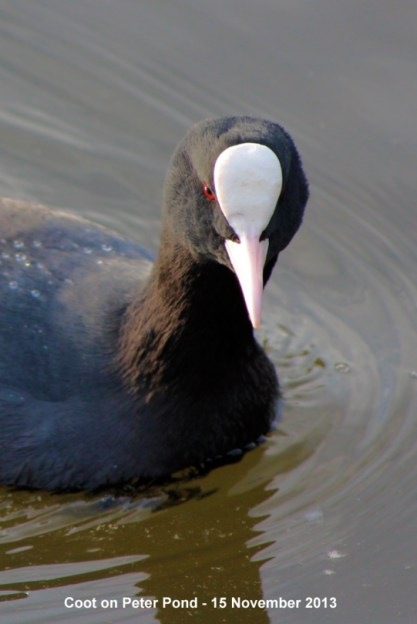
THURSDAY
NOVEMBER 14 - 2013
EMSWORTH
HARBOUR
11:30 - 12:30 - Tide
falling from high water at 09:00.
At Nore Barn the
Spotted Redshank was in the stream with
Greenshank. Also, 9 Mute Swans including the Mute Swan
family with one cygnet from Peter Pond. About 10
Black-tailed Godwits were feeding on the mudflats in
Nore Barn Creek.
I counted 172 Brent
Geese with just two juveniles as I walked towards
the village along Western Parade. My juvenile
proportion is falling rapidly as the flocks build up
in the harbour.
I and others were
interested to watch a fellow standing on the millpond
seawall hand feeding Black-headed Gulls. He
told me he often does this and the gulls get to know
him.

BROOK
MEADOW
Following the
discovery of a dead Water Rail on Lumley Road, Tony
Wootton put in a couple of hours around the meadow
this morning looking for one, but had no luck. But
they are very secretive creatures and not easy to see,
so keep trying! However Tony did enjoy seeing
Goldcrest, Blue and Great Tits, Moorhen, 3 Wrens and a
Grey Wagtail. Here is Tony's action picture of
the Grey Wagtail on the river near the north bend
where a Water Rail was seen a couple of years ago.
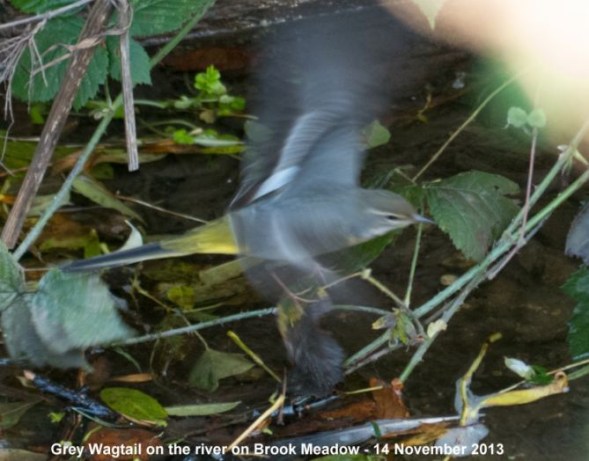
Malcolm Phillips was
on Brook Meadow yesterday when he captured this image
of a male Chaffinch on the river, maybe
thinking about bathing, or just paddling.

OTHER
NEWS
Greenshank
GY+GY at Nutbourne
In response to my
query about the state of Greenshank ringed GY+GY,
which I have not yet to seen this winter in the stream
in Nutbourne Bay, Anne de Potier informs me it is
well, but has only been seen on the Thorney Deeps:
12-Aug-13, 22-Aug-13, 23-Aug-13, 06-Sep-13, 07-Sep-13,
04-Nov-13. Surprisingly, there have been no sightings
so far at Nutbourne where it has been a mega regular
for many years. GY+GY was first ringed on 24.8.02 as
an adult, and it's been seen every year since then.
That makes it at least 12 years old, but not quite a
record yet - another 4 years to go!
See . . . http://blx1.bto.org/ring/countyrec/results2012/longevity.htm
I first saw GY+GY at
Nutbourne Bay on 19-Nov-04 and have seen it most years
since then. It is a very easy bird to photograph as it
usually feeds close to the footpath which goes over
the stream. Here is my first ever photo of the bird in
December 2006.
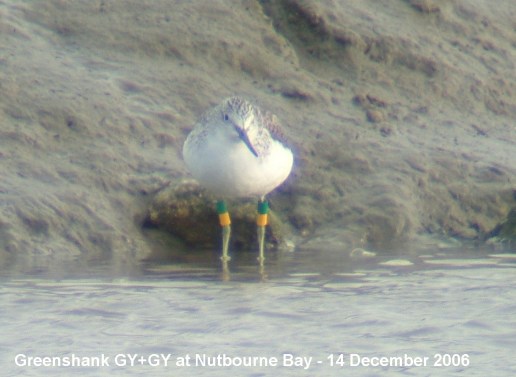
Kestrel
with prey
With reference the
Kestrel in yesterday's blog entry, Brian Lawrence sent
me another image showing the bird with the prey in its
claws. Something brown and furry. Can anyone go
further?

Arundel
WWT
Mike Wells got his
first ever photo of a Kingfisher from inside
the cafeteria overlooking the re-vamped pond at
Arundel Wildfowl and Wetlands Trust Centre. What a
great way to start! Mike's bird is a male from its all
black bill, the female would have red on its lower
mandible.
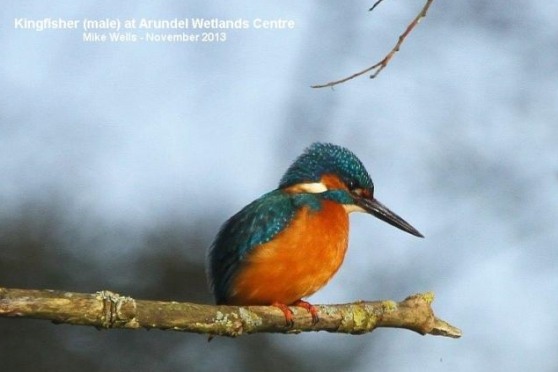
Mike also reports that
the Water Voles at Arundel are positively
'brazen' compared to the shy variety at Brook Meadow,
and they actually seem to pose for the camera! They
clearly are so tame having got used to visitors
pointing cameras at them.
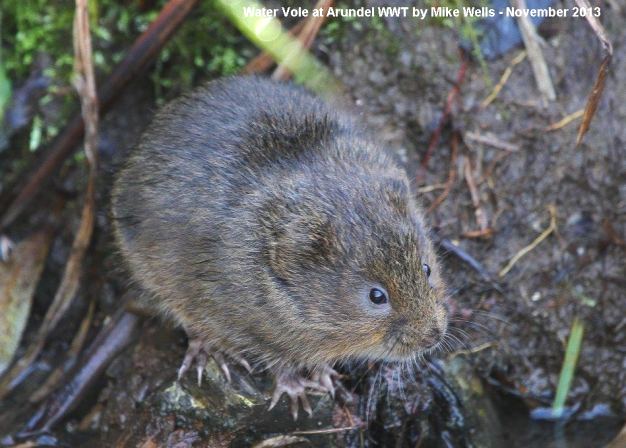
Isle
of Wight news
Hampshire Wildlife
Trust reports that three white park cattle are now
grazing on Ningwood Common on the Isle of Wight to
help manage the grassland for the very rare Reddish
buff moth, the only known site for females. It is
hoped that through a combination of micro management
techniques and grazing the habitat can develop. See .
. . http://www.hiwwt.org.uk/news.php/854/cattle-grazing-to-help-save-reddish-buff-moth
WEDNESDAY
NOVEMBER 13 - 2013
Nore
Barn
10:30 - About 3 hours
after high water. A single Spotted Redshank was
feeding in the stream; there was no sign of the other
one that was here yesterday.
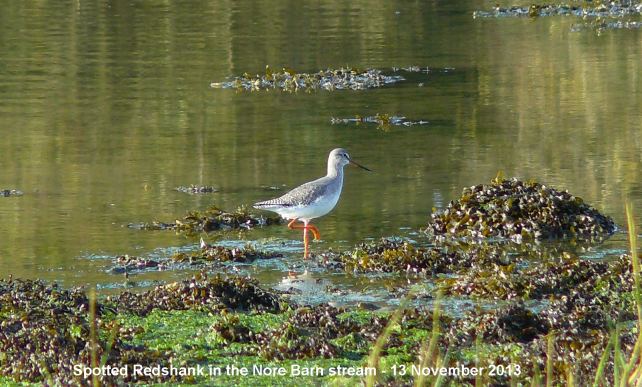
The only other birds
in the stream were two Mute Swans and a Black-tailed
Godwit. Brian Lawrence was there a bit later and said
the Greenshank also arrived in the stream. I decided
not to stay any longer as there was quite a bit of
disturbance from workers in two large white vans (one
Environment Agency), which I think were doing some
work on the stream further north. So, I decided to go
over to Nutbourne to see what was in that stream -
very little as it happened.
Nutbourne
Bay
11:00 - Unfortunately,
there was very little in the small stream that enters
the bay apart from 4 Common Redshanks and a lone
Little Egret. No sign of any Spotted Redshank or even
of the long staying Greenshank GY+GY. Has it been
actually been seen by anyone this year? About 200
Dunlin were busily feeding on the edge of the falling
tide along with a few Black-tailed Godwits, which
looked as though they were 'spurting' so I took some
photos. Sure enough I did capture one bird in the act
as shown here.
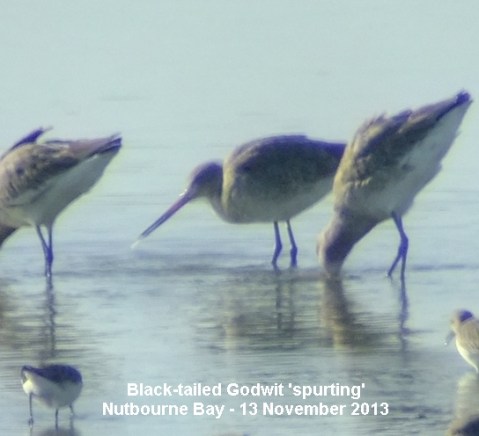
For more information
about this strange behaviour which has puzzled the
boffins go to . . . http://www.emsworthwildlife.hampshire.org.uk/spurting.htm
There were another 50 or so Black-tailed Godwits
roosting on the shingle spit. There was no sign of the
Avocets seen recently by Ralph Hollins. A Cetti's
Warbler was singing from the reedbeds where I saw a
Red Admiral in flight.
A photographer I met on the seawall spotted this dark
juvenile Buzzard sitting in one of the tall
trees on the west side of the meadow. It looked so
small that at first I thought it must be a
Sparrowhawk, but the pale band across the lower breast
was the give-away. Here is my digiscoped photo of the
bird.
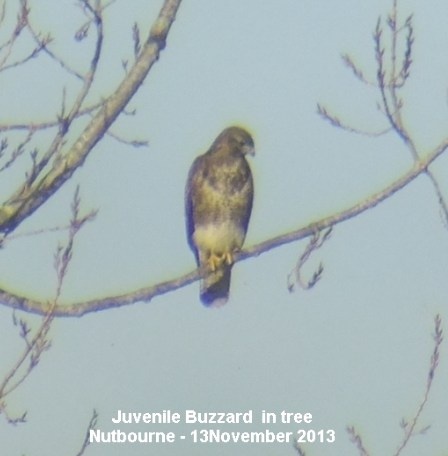
Bosham
Channel
12:00 - From Nutbourne
I went over to Bosham, but there was nothing of
special interest either in Colner Creek or in the main
channel. 15 Black-tailed Godwits were on the mudflat
to the east of the main village, but no colour-rings.
There was just a scattering of Black-tailed Godwits
elsewhere. Overall, not a terribly productive day!
OTHER
NEWS
First
frost
Maurice Lillie enjoyed
the first frost of the winter on his walk through
Brook Meadow early this morning. What an amazing
morning. Amongst lots of other photos Maurice took
this one of frost on an ex flower head.
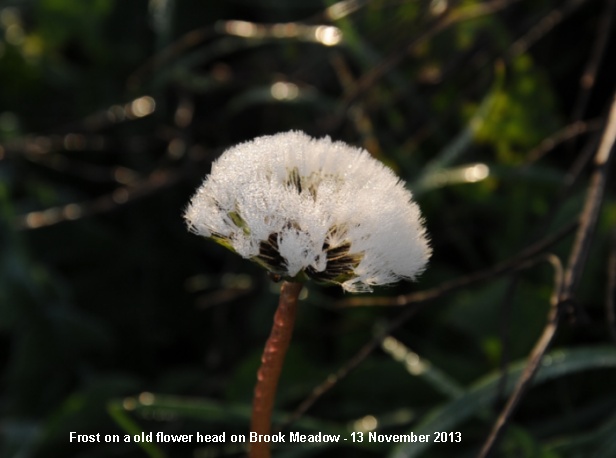
Kestrel
with prey
Brian Lawrence got
this cracking image of a female Kestrel with a prey,
which Brian said looked like some sort of rodent.
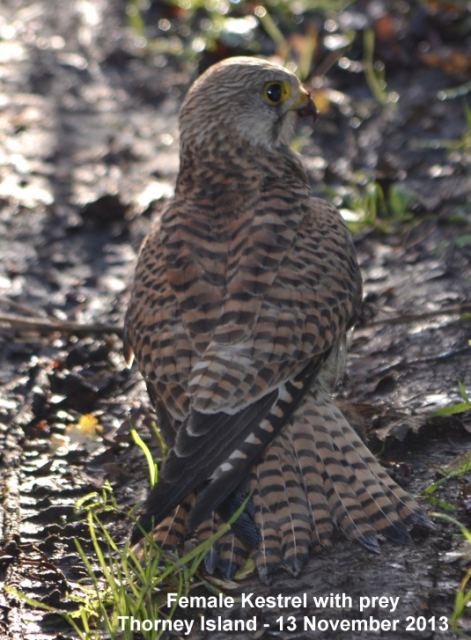
Starlings
Millions of Starlings
come to Britain from the Continent in late October and
November to take advantage of our milder conditions.
We get them down on the Thorney Deeps and at
Farlington Marshes, but they very rarely come into my
garden like they used to 10 years ago. However, when
you can get a view of one they are really splendid
birds with glossy iridescent plumage.
This
Starling that I took at Nore Barn in early October is
probably a resident
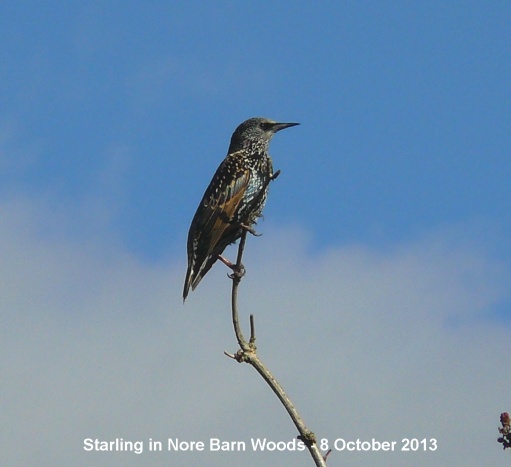
The numbers that
winter here are not as high as they used to be and the
reporting rate continues to fall. However, this is a
peak time of the year for seeing Starlings as shown in
the following BTO Birdtrack chart.
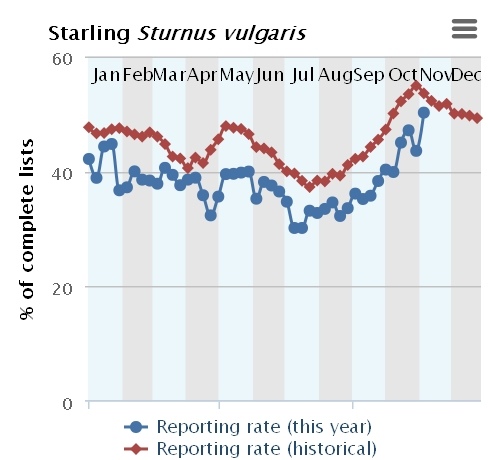
BTO reported more than
flocks of 10,000 Starlings were logged on 3 different
dates in late October at Hunstanton, Norfolk, and many
of these arrivals already seem to have filtered
inland. The Somerset Levels are one of the best places
to see the massed flight display as thousands of
Starlings go in to roost. The Ham Wall blog reports
50,000 are now in flight and numbers are expected to
rise. See . . . http://www.rspb.org.uk/community/placestovisit/hamwall/b/hamwall-blog/default.aspx
TUESDAY
NOVEMBER 12 - 2013
EMSWORTH
HARBOUR
Two
Spotted Redshanks
Nore Barn - 09:30
About 3 hours after high water. Two Spotted Redshanks
were feeding together in the stream. At times they
were very close, giving the impression they were
enjoying each other's company. This is the third time
I have seen a pair of Spotted Redshanks in the Nore
Barn area, though the first time feeding in the
stream. We had a a number of sightings of two Spotted
Redshanks last winter, so this is not unexpected.
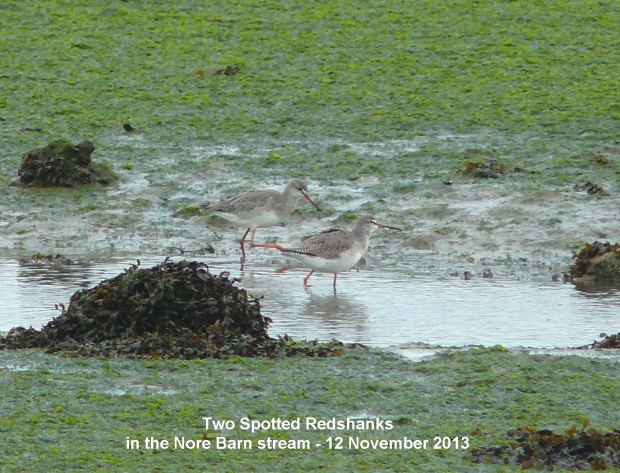
My first Common Gull of the year was sitting
alone on the mudflats.
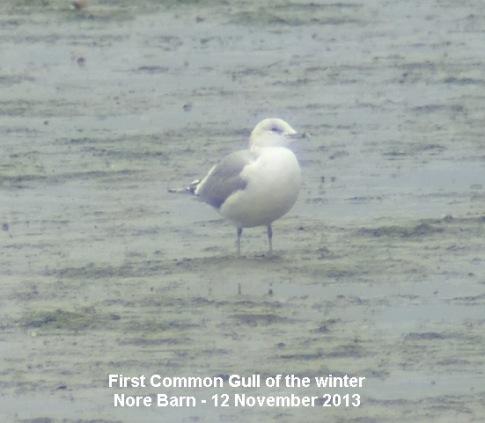
Emsworth
Harbour (east
and west) - 12:00 Low water.
Four Greenshank
were feeding in the low water channel near the town.
One was colour-ringed: RG+BY (geo) - This is one of 3
Greenshanks that Pete Potts caught at Thorney and
fitted geolocators to the blue rings. This was the 4th
sighting of this bird in Emsworth this season. It has
also been seen at Warblington by Peter Milinets-Raby.
I counted 324 Brent
Geese in the harbour including 19 juveniles in
broods of 3, 3, 2, 2, 2, 2, 2, 2, 1. So far this
winter I have aged a total of 696 Brent Geese with 63
juveniles ie 9.05%
Insects
There were lots of
insects feeding on the large Ivy hedge at the end of
Warblington Road. Here are photos of the main
characters:
tentatively, from left to right Bluebottle Fly, Common
Wasp, Drone Fly (Eristalis tenax) and Hoverfly
(Syrphus ribeslii).
Horse
Chestnut Gall
Jennifer Rye called at
my house this afternoon carrying a plastic bag
containing a large gnarled lump of wood which she had
just found on the ground beneath the large Horse
Chestnut tree which leans over the path leading from
Kings Road down to Dolphin Creek. It had clearly
broken away from the tree. It is roughly round, about
18cm across and weighs about 1kg. It would have given
anyone standing beneath it when it fell a nasty
injury. To give an impression of its size here is a
photo of me holding it.
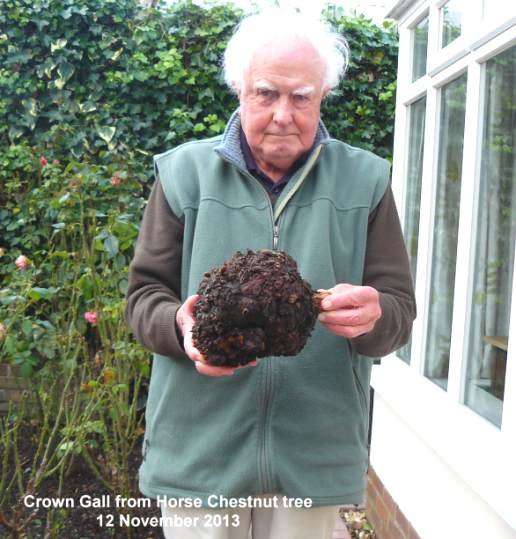
Neither Jennifer or I
had ever seen anything like it before, so she left it
with me for identification. Putting Horse Chestnut
gall into Google soon came up with an answer from . .
. http://adventuresofawildlife.com/2013/01/31/galls-on-other-trees/
These
irregular woody masses are commonly known as Crown
galls. They occur on many different plants and
generally caused by bacteria. This Horse Chestnut tree
has been galled by a common bacteria called
Agrobacterium tumefaciens, which galls hundreds of
other plants as well as Horse Chestnut. The galls form
on the branches and also on the trunk of the
tree.
MONDAY
NOVEMBER 11 - 2013
Dead
Water Rail
Michael Farley found
what he described as 'an immaculate, mature Water
Rail' dead on the road between Brook Meadow and
Slipper (presumably Lumley Road) this morning at 7.00
a.m. Michael is a taxidermist and says he will mount
it this week. Here is a photo of the bird. Michael
said it had a small amount of blood on other side of
head, probably from a glanching blow by car. He thinks
it will look good mounted in a little clump of reeds.

This discovery is a
sign that Water Rails are on the move through our
area, so we shall need to keep a look out for them on
the Brook Meadow waterways. Water Rail is not a common
bird, though we usually get one or two turning up.
Last winter one was seen on the River Ems on Brook
Meadow near the sluice gate on 18-Dec-12 and remained
in the area until at least 24-Mar-13, giving good
sightings and photo opportunities in the
meantime.
Here
is a nice shot that Malcolm Phillips got in January
this year.

Avocets
at Nutbourne
Ralph Hollins reported
that 14 Avocets were back in Nutbourne Bay yesterday
(Nov 10) - the first at this location of the winter
season. See Ralph's diary entry for more details . . .
http://ralph-hollins.net/Diary.htm
These attractive birds are regular winter visitors to
Nutbourne Bay, but never to Emsworth. Why is that I
wonder? Numbers usually build up to between 20 and 30
as the winter develops. They are probably from the
breeding colonies in Suffolk, Essex and Kent. I recall
well seeing a flock of 14 in Nutbourne Bay on Nov 11
last year. The best place to see them is from the
seawall at the end of the footpath from the end of
Farm Lane.
Here
is a photo of a few of them by Richard Somerscocks in
February 2012 at Nutbourne.
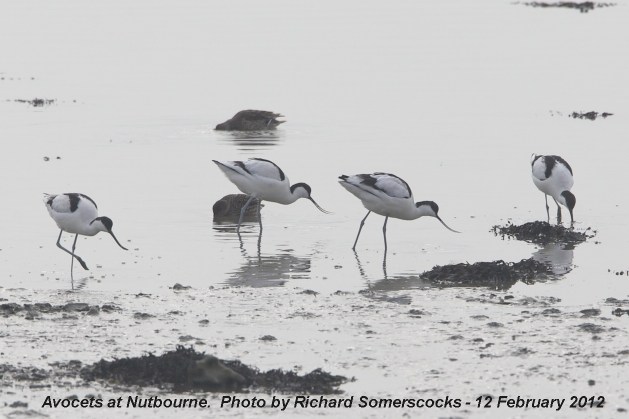
Stonechats at Farlington
Colin Vanner was on
Farlington Marshes on Sunday with his fine camera and
got a number of images of Stonechats. I have picked
out this one for the blog which I think is a first
winter bird (ie born this summer) showing very nicely
its warm brown plumage and chestnut rump.

SUNDAY
NOVEMBER 10 - 2013
Maurice Lillie had
some interesting observations at Slipper Millpond
today. "Gull floats along clearly searching for
something. Sees whatever. Launches itself into the air
about 75cms and dives into the water.
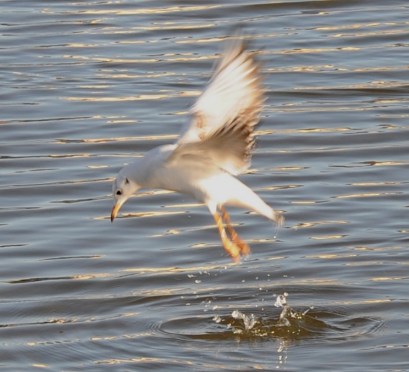
Disappeared
momentarily below the surface and reappears nothing in
beak. Repeated several times. If it caught anything,
it must have swallowed before resurfacing. What a
magical place we live in!"
Malcolm Phillips got a couple of good images during a
walk down the Thorney west bank this afternoon.
Goldfinch
taking seeds from Lesser Burdock burrs
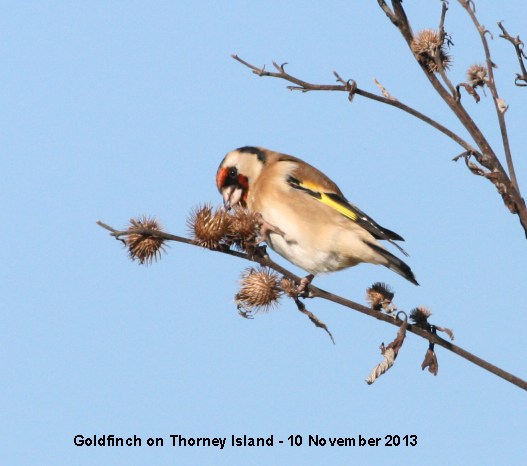
Female
Reed Bunting
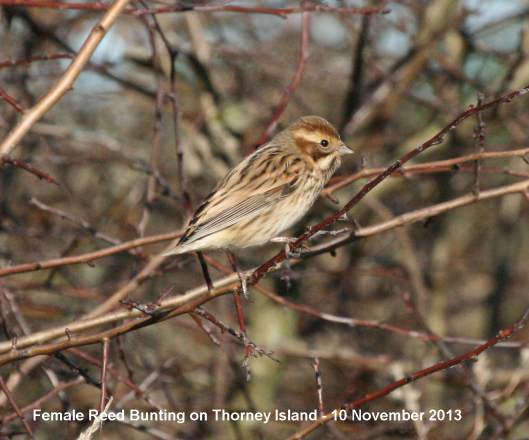
FRIDAY
NOVEMBER 8 - 2013
EMSWORTH
Emsworth
Millpond
Jennifer Rye reported
the presence of two 'very slim and elegant blackish
diving birds' on the town millpond yesterday. She did
not think they were Cormorants, so my guess is Great
Crested Grebes which we do get on the millpond from
time to time in the winter. I was hoping they might be
there when I passed this morning, but there was no
sign of them. However, someone did mention that he saw
two Little Grebes on the millpond recently though they
are hardly 'very slim and elegant'. We do get both
Little and Great Crested Grebe in winter, of course.
Eastern
harbour
I took my scope around
the harbour this morning from 11:00 to about 12:00.
The tide was rising to high water at 14:30. From the
millpond seawall, I could just make out 4
Lapwing on the seaweed island in the main channel
- my first of the year. About 20 Black-tailed Godwits
and 100+ Brent Geese were on the far marina shore.
Nore
Barn
Brent Geese -
120 including just 3 juveniles (broods of 2 and 1)
were on the western mudflats. 10 Mute Swans
were in the Nore Barn stream including what I
think is the Peter Pond cygnet.
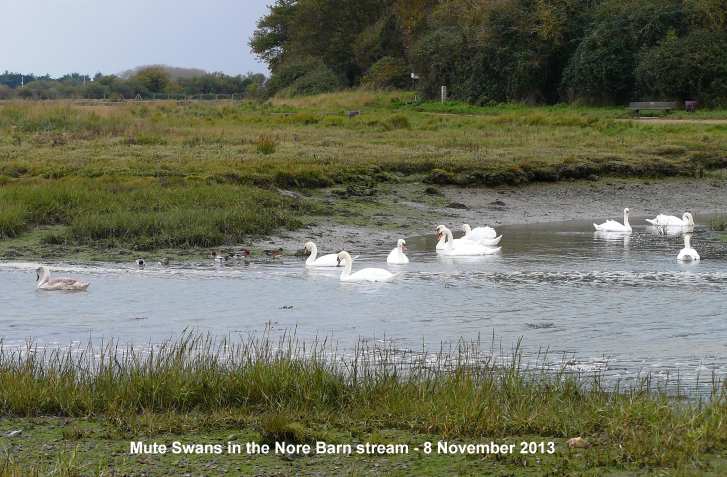
The Spotted
Redshank, Common Redshank and Greenshank were
feeding in close proximity in Nore Barn stream along
with a few Wigeon. A Little Egret was feeding in the
upper stream near the bridge.
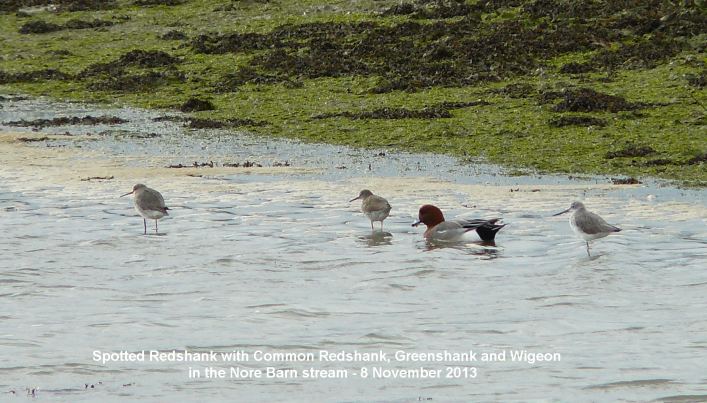
I was pleased to meet
Katie and David a couple of birdwatchers from
Manchester who were staying in Southsea where their
daughter lives. They were delighted to see all three
'shanks' in the stream.
Black-tailed
Godwits - 88 flew onto the mudflats in Nore Barn
Creek where they fed on the near shore before flying
over to the far shore by the saltmarshes. Most were in
water, so I was only able to check a few of them for
colour-rings. I found just two colour-ringed which are
regulars here this winter: W+WN and WO+LW flag. I
captured a couple of examples of the Godwits
apparently 'spurting' water from their
bills.
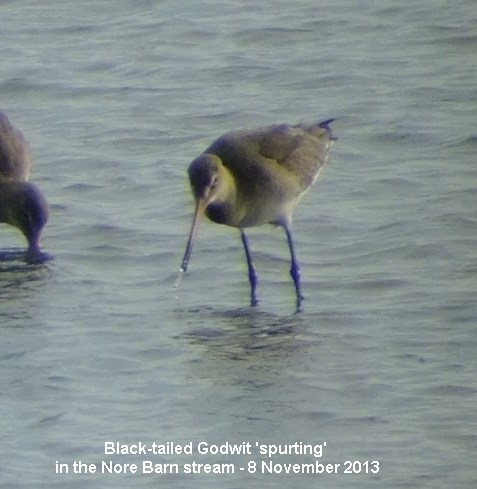
See the following link
for more details about this puzzling behaviour. . . .
Spurting
behaviour
Brook
Meadow
Maurice Lillie noticed
two things of interest during his walk through Brook
Meadow this morning. Firstly, the Rowan
plantation on the east side of the north meadow
was alive with bird activity, including Blackbird,
Great Tits, Goldfinches and possibly Siskins. This is
not surprising considering the magnificent crop of
berries the trees have this year.
Secondly, he had
always understood that Ivy grows up trees for
support only and does the tree no harm. Well, today he
observed that ivy, having been severed from its roots
last year, is still in full leaf and healthy. He
thought this must mean it is taking nutrients from the
tree in some way or maybe is it living off atmospheric
moisture only? I turned to the web site of the Royal
Horticultural Scoiety for advice on Maurice's
question. The advice was clear: "Ivy is not a
parasite; the short, root-like growths which form
along climbing stems are for support only. Its own
root system below ground supplies it with water and
nutrients and is unlikely to be strongly competitive
with the trees on which it is growing."
Maurice also reminded
us that he and Nigel planted three Alders in
the Palmers Road Copse on 29 October. They were good
specimens supplied via Havant Borough Council through
the tree warden fund administered by Frances Jannaway.
These trees are easily seen on the west bank of the
river from the main path through the copse and nicely
compliment those already gorwing there.
RED-NECKED
GREBE OR NOT?
Roger Pendell has
heard from Paul James of the SOS who said the
'Red-necked Grebe' that he photographed at Prinsted on
Nov 2 was in fact a Little Grebe. Consequently, the
sighting has been taken down from the SOS sightings
list. Personally, I thought the photo looked OK for a
Red-necked Grebe as did Barry Collins, Anne de Potier
and Ed Rowsell. However, none of us actually saw the
bird and overall size would have been critical as
Little Grebe is almost half the size of a Red-necked
Grebe. This is always the problem with an
identification based purely on a photo. Also, my alarm
bells did start to ring when I learned from Roger that
he had photographed it in a ditch inside the seawall,
not the best habitat for a Red-necked Grebe I would
have thought. Peter Milinets-Raby also replied to say
he was not convinced the photo was of a Red-necked
Grebe and thought it looked more like a Little Grebe.
Here
is Roger's photo of the mystery grebe. What do you
think?
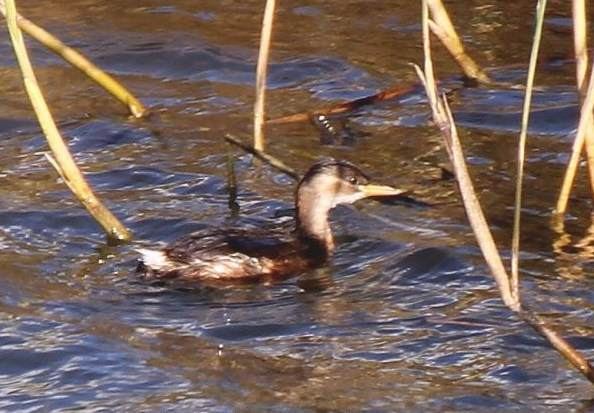
WEDNESDAY
NOVEMBER 6 - 2013
NORE
BARN
10:00 - 11:00 - Tide
rising to high water at 12:45. The wind was fairly
strong, but the rain held off while I was there. It
was good to meet up with Richard Hallett again who was
making his first visit to Nore Barn of the winter.
Birds in the stream
were much the same as yesterday with the Spotted
Redshank and a Common Redshank again feeding closely
together and seemingly enjoying one another's company,
unlike in previous years. It now seems that the
Spotted Redshank is getting back to its old feeding
routine after a couple of weeks away and should be a
reliable sighting 2-3 hours before (and after) high
water. Other birds feeding in the stream were
Greenshank, three Black-tailed Godwits, the usual
Little Egret.
Spotted
Redshank flanked by a Black-tailed Godwit and a Common
Redshank
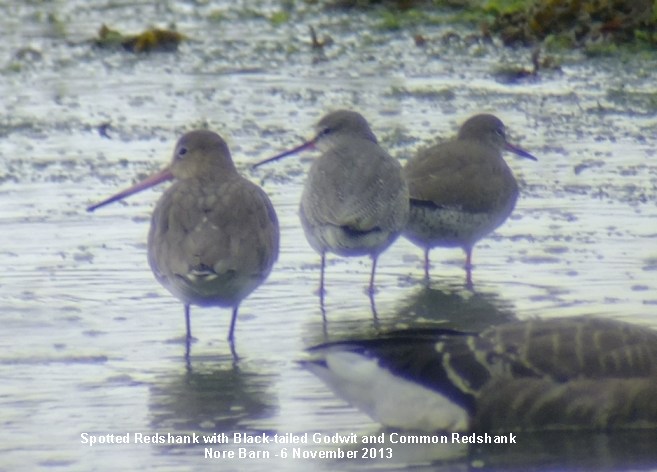
For
all the Spotted Redshank news and photos go
to . . .
Spotted
Redshanks
I counted 96 Godwits
feeding busily on the edge of the rising tide, about
60 less than yesterday's total. As most of them were
in water I was only able to check about half of them
for colour-rings: The ones I saw were all regulars:
G+WR, R+YN, W+WN, WO+LW flag.
Colour-ringed
Black-tailed Godwit - WO+LW flag - feeding with
friends
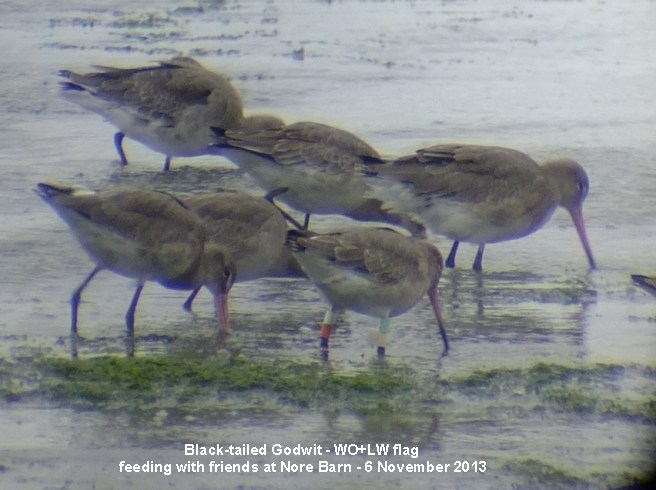
For all the godwit
news and sightings go to . . . Black-tailed
Godwits
There were also six
Mute Swans, including the family with one cygnet
from Peter Pond; the other Emsworth Mute Swan family
with one cygnet was on the town millpond when I
passed.
I counted 44 Brent Geese on the water including
3 juveniles, I think in broods of 2 and one. There
were also about 50 Wigeon milling around.
RED-NECKED
GREBE
NOTE:
The identity of this bird is in dispute. See the
discussion on the following day's entry (Nov 8)
Tony Wootton sent me a
photo of what looked like a Red-necked Grebe. It was
taken by his friend Roger Pendell on Nov 2 at about
11am at the top of Prinsted channel at Grid Ref: SU
767 048.
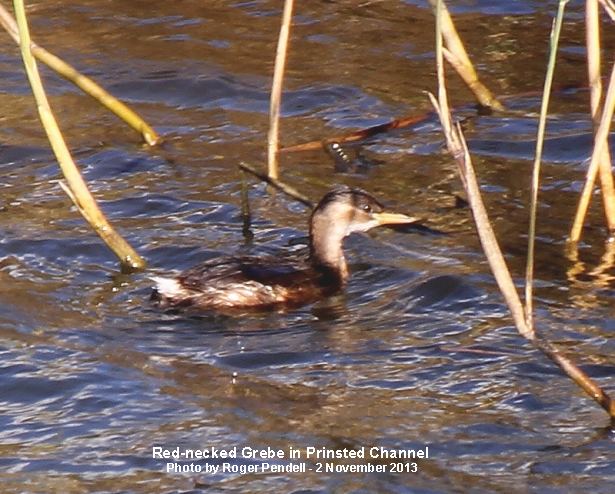
I passed the photo on
to Barry Collins and Anne de Potier for their view and
both thought it looked like a Red-necked Grebe. Anne
added that she remembers seeing one off Nore Barn a
few years ago, so they are possible up at the tops of
channels. Red-necked Grebe is described as "A very
scarce winter visitor and passage migrant" in the
Sussex Bird Report with only 8 records in the whole of
Sussex in Year 2011. Interestingly, one of those was
on Nov 11th in Chichester Harbour entrance. BTO
Birdtrack shows a substantial jump in sightings of
Red-necked Grebe in October this year, so this
sighting could be one of many. See . . .
http://blx1.bto.org/birdtrack/main/data-home.jsp
NOON
FLY
Ralph Hollins is
fairly sure he has cracked the identity of the large
black fly with very distinctive orange bases to its
wings which I found on Brook Meadow on Oct 27 and
which he himself has seen several times recently. It
is Mesembrina
meridiana
or Noon Fly, but Ralph adds you would never have
recognized it from Chinery's illustration on his page
214.
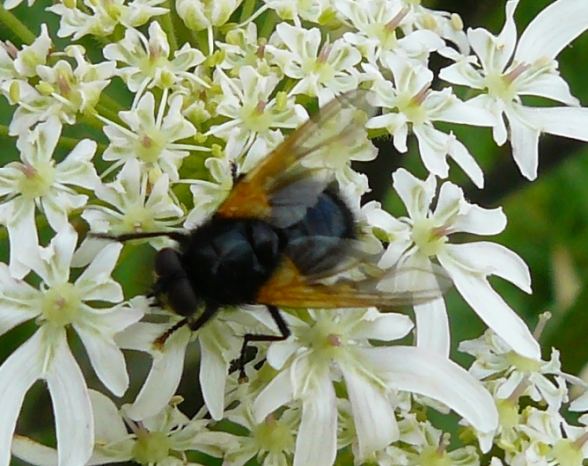
For a good photo Ralph
also suggested . . . http://www.uksafari.com/noonflies.htm
The book "Insects of the British Cow Dung Community"
(a good Christmas present?) says " Adults are most
often seen on cow dung, basking in open ground or
visiting flowers to feed upon nectar. Eggs are laid in
cow dung, the larvae are carnivorous, and feed on
other fly larvae within the dung. The female lays up
to five eggs in a lifetime, each one in a different
pat, at two day intervals"
TUESDAY
NOVEMBER 5 - 2013
NORE
BARN
09:00 - 10:00 - Tide
rising to high water at 12 noon. The rain was falling
steadily which did not help birdwatching, but the wind
had dropped. The harbour was gradually filling up with
water while I was there.
Spotted
Redshank
Birds in the stream
included Spotted Redshank, Greenshank and Common
Redshank. It was good to see the Spotted Redshank back
in the stream after a short absence. Let's hope it now
resumes normal activity. I admit I was surprised to
see the Spotshank and Redshank feeding so happily
together, as the former has usually seen off the
latter in previous years.

Also in the stream
area were 6 Mute Swans including one cygnet, probably
the one from the Peter Pond nest.
Black-tailed
Godwits
A large flock of
Black-tailed Godwits came swirling down onto the
mudflats off Nore Barn at about 09.30, a great sight
indeed. I counted 168 which is the largest number here
so far this winter, in fact, the largest number since
187 on 29-Oct-11. I found 6 colour-ringed birds among
them, though there could have been others as many of
the birds were up to their bellies in water. All were
regulars this winter: G+BG, G+WR, R+YN, W+WN, WO+LW
flag, ROL+RLR.
SLIPPER
MILLPOND
A Great Black-backed
Gull was squatting on the top of the nesting box on
the south raft. There were 6 Cormorants on the centre
raft.
OTHER
NEWS
Eric Eddles had a
thrill to see this Guillemot a thrill when this
Guillemot surfaced off the end of the Great Salterns
jetty on the Eastern Road. Its brown plumage suggests
it is a juvenile bird.
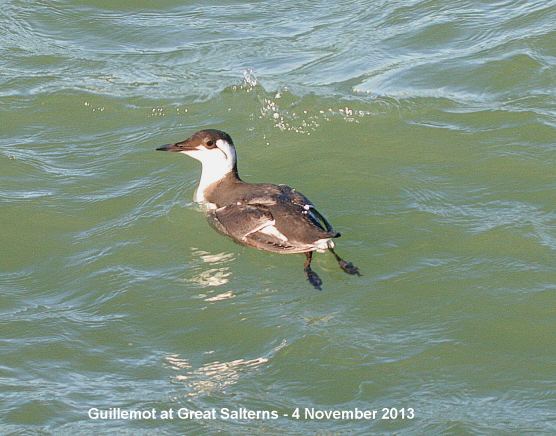
MONDAY
NOVEMBER 4 - 2013
BROOK
MEADOW
I had a walk through
Brook Meadow this morning during which I met up with
Brian Lawrence. Brian told me about the Spotted
Redshank he had seen at Nore Barn yesterday - see note
below. We walked down the main river path, looking for
insects basking in the sunshine on the nettle leaves.
We found a 'Nursery-web spider' (Pisaura mirabilis)
with 6 of its legs tucked up and the back two
stretched out, a Hoverfly (Syrphus-ribesii) was
feeding on a Hogweed flower head and a Yellow Dung-fly
- Scathophaga stercoraria
Nursery-web
spider' (Pisaura mirabilis) . . . . . . Hoverfly
(Syrphus-ribesii
Yellow
Dung-fly - Scathophaga stercoraria
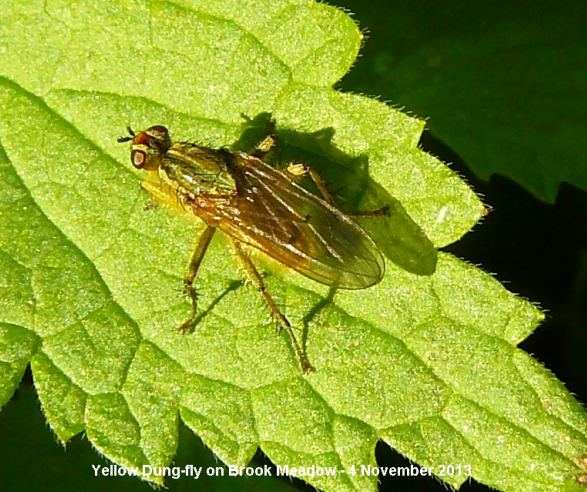
I tend to see these
attractive gingery flies on the Hogweed flowers at
this time of the year, but this one was on nettle
leaves. They are mostly predators on smaller insects,
but will also feed on pollen. Both males and females
are found on dung, hence their name, the males only
feeding on other insects that visit dung, such as
blow-flies. Females will be there both to feed and
oviposit on the dung surface.
Birds
Brian and I watched a
female Kestrel settle in a Crack Willow tree by
the main path after being harassed by a Magpie. After
a minute or so searching the area beneath the tree,
the bird then dropped to the ground and flew off with
a small prey. Brian captured images of the bird in the
tree and then as it launched itself to the ground.
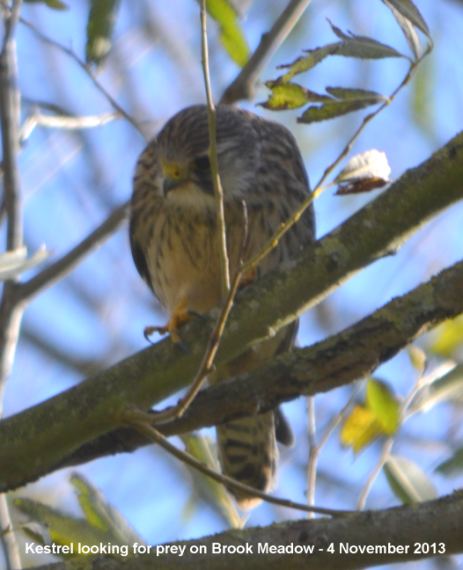
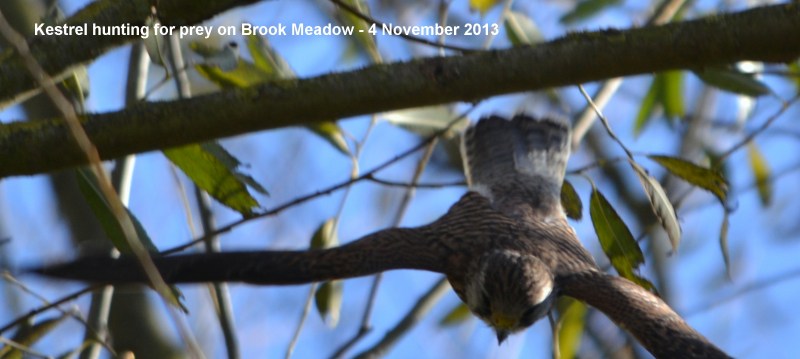
A Little Egret feeding on the flooded Lumley
area at 11.30 at a high spring tide.
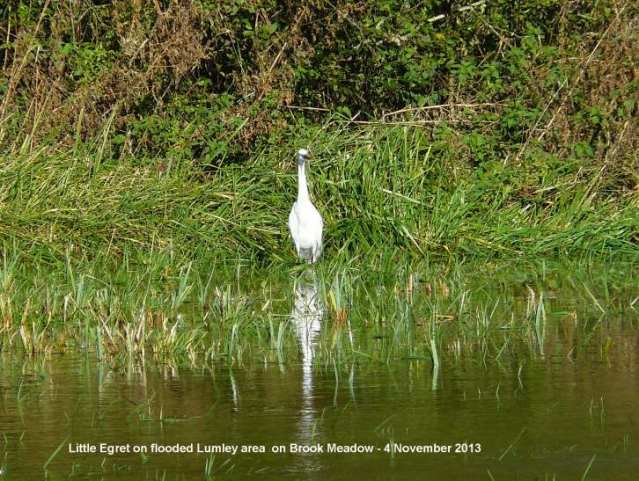
OTHER
NEWS
Spotted
Redshank
I met Brian Lawrence
on Brook Meadow this morning and he told me the good
news that the Spotted Redshank was back in the Nore
Barn stream yesterday afternoon. This was our first
sighting since Oct 22. Hopefully, this signals a more
regular appearance from this familiar bird.

Mute
Swans at sunset
Juliet Walker took
this rather fine atmospheric photo of a flock of swans
(including the cygnet) at the seaward end of the town
millpond at sunset. Good to see the swans coming back
onto the millpond.
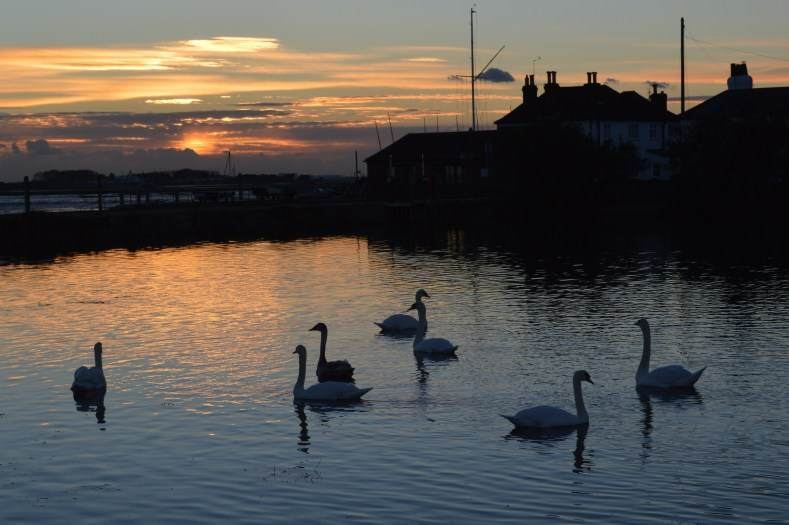
SUNDAY
NOVEMBER 3 - 2013
BROOK
MEADOW
Conservation
work
I went over to Brook
Meadow this morning for the regular Sunday morning
conservation work session. It was well attended with
11 volunteers on a bright but chilly morning. The main
task for the morning was to use the recently
refurbished power scythe to cut the orchid area in the
north meadow and to clear the arisings to a
sacrificial dumping area.
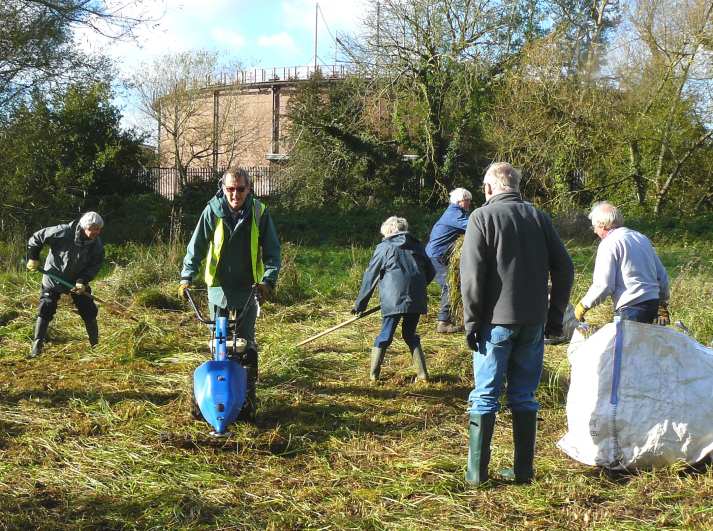
Harvest
Mouse nest
Maurice Lillie showed
me what might have been the remains of a Harvest Mouse
winter nest that he found while clearing some tall
grasses.

The full nest is woven
into a spherical ball and suspended in tall grasses.
Winter nests, where the animal spends much of the
winter, are more loosely woven and bulkier than the
breeding nests, presumably to keep out the winter
cold. We do occasionally come across these nests
during the clearance work at this time of the year.
The last one was on 16-Dec-07.
Ralph Hollins
comments
During a conservation
work session at Brook Meadow in Emsworth on Sunday Nov
3 a rough ball of grasses woven together was found in
some of the long grass being cleared and was
probably the breeding nest of a Harvest Mouse -
similar nests have been found here in previous years
but as far as I know the mice have never been seen
(not surprising as they are small and secretive and
are most active around dawn and dusk). They construct
two different types of nest, one for breeding in the
summer which is likely to be a bit larger than a
Tennis Ball and postioned up to a metre off the
ground, suspended in long grass (including reed beds)
or in a hedgerow, and one for use by single adults in
the winter and this is likely to be on or below the
ground, probably at the bottom of a hedge though it
can be in a building. In a mild winter such as the
current one breeding can continue into December. The
distinctive features which separate Harvest Mouse
nests from those of birds (Wren or Long-tailed Tit)
are that they are round (bird nests are more like
Rugby Balls than Footballs) and are made of grass
blades which have been split into thin strips but
remain joined at the base, while the breeding nests do
not have an obvious opening (the mother pushes her way
through the outer wall which closes up behind her,
though when the nest is abandoned at the end of summer
there will probably be an obvious hole). The winter
nest is smaller (no more than 5cm in diameter),
positioned on or near the ground and could be confused
with nests of other small mammals. Harvest mice do not
hibernate so the winter nests are not designed for
long term use.
Red
Admirals
I have been seeing Red
Admirals everywhere recently, basking in the warm
sunshine. The Michaelmas Daisies on Brook Meadow are
particularly attractive to them. I saw a real beauty
during the work session this morning at the north end
of the Bramble path. This fellow showed well both its
upper wings and its underwings.
Red Admirals try to
hibernate for the winter, though most do not survive;
the few that do can often be seen flying on warm days.
Thankfully, a fresh wave of adults will teem
northwards to us from the Mediterranean in the spring
and the whole process starts again.
WARBLINGTON
BIRDS
Peter Milinets-Raby
had a visit this morning to Warblington shore (7am to
9am). The highlights were as follows:
Off Pook Lane: 61
Bar-tailed Godwit, 14 Black-tailed Godwit (one with
coloured rings L-R/WR), 86+ Dunlin, 10 Lapwing, 14
Wigeon, 3 Shelduck, 46 Brent Geese, 12 Grey Plover,
Great Crested Grebe.
Off Conigar Point: 67
Brent Geese, 9 Shelduck, 27 Wigeon, 2 Teal, 21 Grey
Plover, Single Turnstone, 140+ Dunlin. Cetti's Warbler
seen in Tamarisk trees.
Curlew back in Ibis
field and 5 Meadow Pipits over was the only migration
movement noted.
Note on the
colour-ringed Black-tailed Godwit. L+WR has
been seen a few times before in Emsworth Harbour, but
not since 31-Mar-12.
Peter also found the
following fungi growing at the base of what looks like
a Silver Birch tree in Warblington Cemetery. They
could be Honey Fungus though I am no expert!
Cemetery
fungi
Peter also found the
following fungi growing at the base of a tree in
Warblington Cemetery. They looked like Honey Fungus to
me. However, Ralph Hollins went to look at the fungi
photographed by Peter Milinets-Raby. He says, "The
site was easy enough to find (just south of the
cemetery building) but the tree was not a Silver Birch
(my best guess is a Pear tree of sorts). The size and
other aspects of the fungi showed them to be
Gymnopilus junonius or Spectacular Rustgill - see
http://www.hlasek.com/gymnopilus_junonius.html
with two clusters on opposite sides of the tree base.
Near the second cluster were some smaller fungi which
I cannot name for certain but think they are
Psathyrella species by the conical shape of the cap
and their hollow stems."
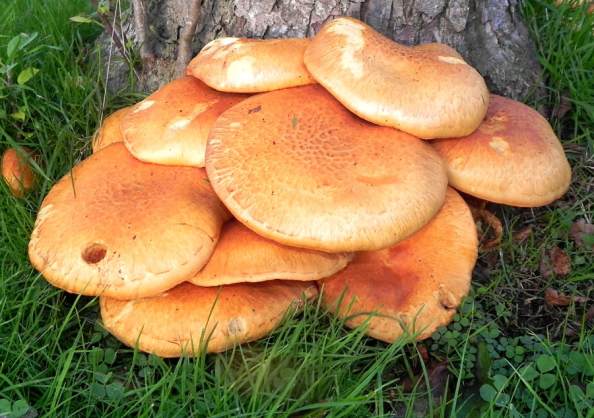
SATURDAY
NOVEMBER 2 - 2013
BROOK
MEADOW
There are three new
Alder saplings on the east bank of the river in
Palmer's Road Copse, presumably planted by HBC.
The splendid
Hogweed flower heads along the main river path
are highly attractive to flies. This morning I found
another example of the hoverfly with longitudinal
stripes on its thorax called Helophilus pendulus.
While up dating the
signcases I discovered a cluster of 4 Harlequin
Ladybirds on the metal frame of the case near the
south gate, all with different patterns of black and
red on their wing cases. They should be looking for
somewhere to hibernate, though I don't think they will
be able to get into the signcase. Here are two of them
for comparison.
HEAD
DOWN
Heather Mills reported
on this morning's walk by the Havant Wildlife
Group
See . . . Havant
Wildlife Group
For
earlier observations go to . . October
1-31